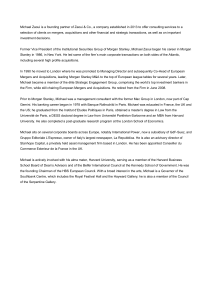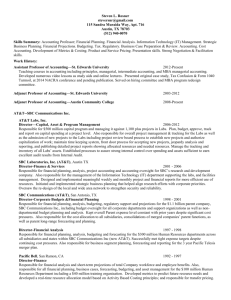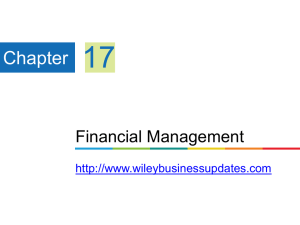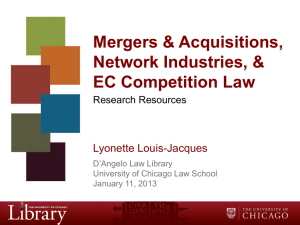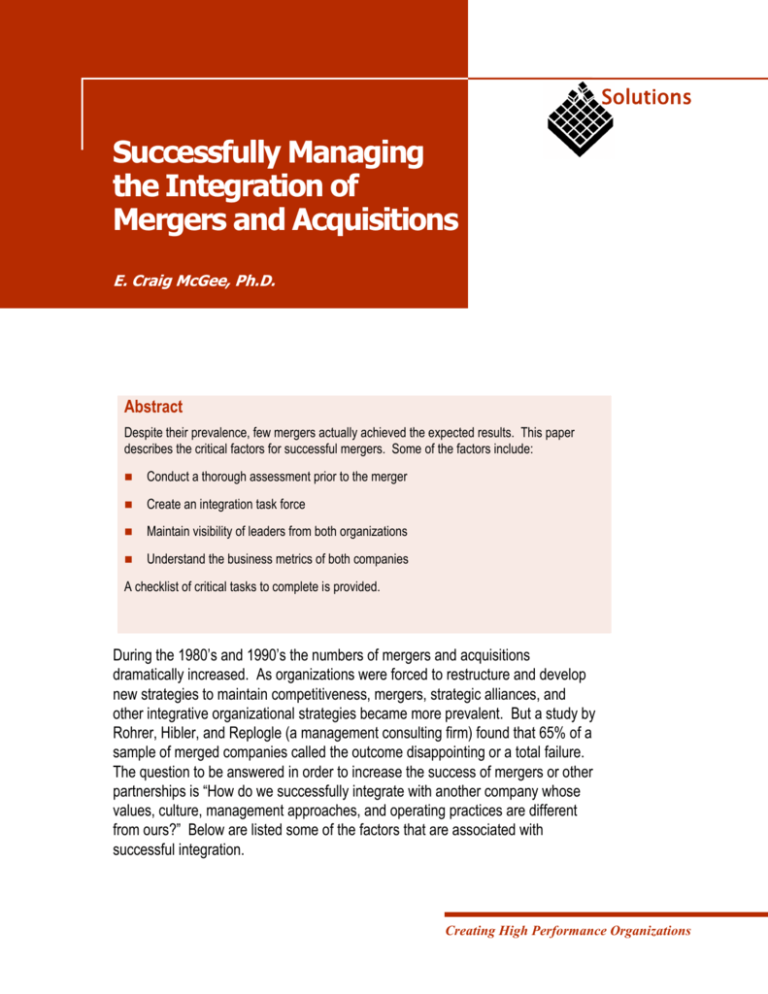
Solutions
Successfully Managing
the Integration of
Mergers and Acquisitions
E. Craig McGee, Ph.D.
Abstract
Despite their prevalence, few mergers actually achieved the expected results. This paper
describes the critical factors for successful mergers. Some of the factors include:
Conduct a thorough assessment prior to the merger
Create an integration task force
Maintain visibility of leaders from both organizations
Understand the business metrics of both companies
A checklist of critical tasks to complete is provided.
During the 1980’s and 1990’s the numbers of mergers and acquisitions
dramatically increased. As organizations were forced to restructure and develop
new strategies to maintain competitiveness, mergers, strategic alliances, and
other integrative organizational strategies became more prevalent. But a study by
Rohrer, Hibler, and Replogle (a management consulting firm) found that 65% of a
sample of merged companies called the outcome disappointing or a total failure.
The question to be answered in order to increase the success of mergers or other
partnerships is “How do we successfully integrate with another company whose
values, culture, management approaches, and operating practices are different
from ours?” Below are listed some of the factors that are associated with
successful integration.
Creating High Performance Organizations
(a
a
l
u
Successfully Managing the Integration of
Mergers and Acquisitions
Solutions
Identify and support the core competencies and
competitive levers of the partner company.
Executives of both companies should ask “What is it about the other company that led us to this
arrangement?” Often the answer to this question is a core competency or body of technology
that needs to be protected. The other question they should ask is “What is it about the other
company that represents a competitive advantage?” Once these areas are identified, conscious
decisions can be made to ensure that they are not minimized during the integration process.
Conduct a thorough organizational assessment prior to
negotiating and closing the partnership agreement.
Most companies carefully inspect the financial performance and product suite of the partner
company. They want to ensure that the partner company is financially viable and has a product
set that is compatible with theirs. However, less attention is given to other aspects of the partner
company such as:
technical competence of the workforce
organization culture and values
metrics used to guide the business
management styles and values
information systems
interpersonal styles
These are critical subjective areas that often make or break successful integration. Consider the
clash in cultures between General Motors and Electronic Data Systems. It took over ten years
for those organizations to integrate. Some people would argue that they never truly integrated
and that is what led to the spinoff of EDS off from GM.
Develop a high-level integration plan during the
negotiations of the partnership agreement.
Based on the organization assessment, due diligence and other assessment work that occurs
prior to the formal closing of the partnership agreement, executives of both companies should be
able to develop a high level plan for how the two companies will operate after the
merger/partnering agreement.
After the announcement of the partnership agreement, quickly
communicate to people what will change and what will stay the
same.
Employees of both companies will naturally have a number of questions about new organization
structures, new reporting relationships, geographic locations of new/merged units, etc. The plan
developed during the negotiations can be an invaluable tool for allaying fears and concerns of
people. Be frank, candid and understanding. Without a clear understanding of what the
direction and plan is, people will create their own reality. They will spend more time creating that
reality in their own mind than performing constructive work. In the absence of clear information,
rumors will develop and spread. Executives and managers of both companies will spend more
time controlling rumors than attending to the true needs of the business.
Create an integration task force.
2
Creating High Performance Organizations
Successfully Managing the Integration of
Mergers and Acquisitions
Solutions
Even with a high-level integration plan, there remains a great deal of “detail” work to execute
that plan. The execution of the integration plan is actually a 4 - 18 month process that must be
carefully managed. And mid-level managers who can be most threatened by the new
partnership, yet know the most about the day-to-day operations needed to support that plan, are
an invaluable resource for executing that plan. A task force charged with working out the
mechanics and logistics of the merger/partnership working relationships plays an important role.
Members of the integration task force should possess greater than
average leadership, problem solving, and communications skills.
Consider that these people will be the ones who interact with the other company the most.
Having the best and brightest people work on the integration will create greater confidence in the
other partner and minimize unnecessary intrusion.
The integration task force should work closely with the senior management of both companies.
In many cases, several of the senior managers will be active, full-time members on the task
force. A senior manager who was deeply involved with the preliminary discussions and final
negotiations should be a member and/or leader of the task group. This manager should be
knowledgeable about the general intent and discussions that occurred during the negotiations
and ensure that the execution of the integration plan is consistent with those discussions.
After the merger/partnership agreement has been signed, the
leaders
of the parent company should be highly visible on the site of the
purchased/merged company.
Activities should be designed that enable the new employees to get to know them and their
management philosophies. These activities include planning sessions, communications
meetings, Q&A sessions, informal forums, roundtables, picnics, etc. This is not a one-shot
exercise. There should be a series of events to allow the employees to get to know the
managers/executives of the parent company better.
Conversely, it is important that the managers and executives of the
acquired company establish a presence within the parent company.
It is important that they protect structures and practices that have led to their success. They
should visit the parent company’s main office to review operating plans, strategies, and major
project status. It is important that they project an image of competence, confidence and
cooperation.
Utilize large group methods to integrate cultures.
Cultural differences between the merging organizations can significantly impact how effectively
the post-merger organization operates and delivers the business results upon which it was
justified. Large group methods effectively eliminate the fear and anxiety associated with
mergers and focus all employees on the strategic objectives required to achieve the desired
synergy. These methods serve as effective communications vehicles to keep people aligned.
3
Creating High Performance Organizations
Successfully Managing the Integration of
Mergers and Acquisitions
Solutions
Effective working relationships need to be built at all levels of the
organization.
It is common for the senior managers who negotiated the partnership agreement to have
developed a strong, cooperative relationship. However, managers at lower levels of the
organization tend to protect existing turf. The integration task force is one means for building the
same cooperative working relationships throughout the two companies. Additional task groups
can be formed to resolve the myriad of integration issues that arise and provide a mechanism for
building these relationships among other people in the two companies. The task groups should
be chartered by the integration task force and report to them during the integration process.
Process mapping is an effective tool for helping managers from the two different companies
understand the operating practices in the other company. It identifies the points in the process
where integration must occur. It identifies redundancies and opportunities for streamlining
existing processes. It identifies information system requirements. Process mapping will
typically surface conflicts in roles and responsibilities among the managers and work groups in
the two companies. The quicker these role conflicts are identified and clarified the quicker the
integration proceeds.
Teambuilding among the new groups can also be helpful. Efforts should be made to create or
identify tasks around which to structure group activities. Successful accomplishment of
meaningful tasks builds effective work teams. Examples of tasks include:
merging the information systems of the two companies
evaluating the benefit plans of the two companies and integrating them if necessary
integrating the product plans of the two companies
clarifying the structure of the sales force and technical support
A group should also be chartered to listen for rumors and respond to
them quickly.
This is often the responsibility of one of the subgroups of the integration task force. This group
is comprised of employees who are well respected and have good working relationships with
their peers. They will be able to hear rumors during their early stages and prevent the spread of
inaccurate rumors.
The attitude of managers and executives of both parties should
reflect one of problem-solving, cooperation and equality rather than
condescendence, superiority or defensiveness.
Senior managers of both companies will need to closely monitor the activities at lower levels of
the organization to ensure that the proper tone and attitude is being promoted. Again, issues of
turf protection and colonization can be very prevalent and must be carefully guarded against.
Sweat the big stuff.
4
Creating High Performance Organizations
Successfully Managing the Integration of
Mergers and Acquisitions
Solutions
Do not allow managers and executives to compromise those core competencies or operating
practices that have made each of the companies successful in their own respect. Senior
managers should be prepared to strongly resist changes they believe will weaken the core
competencies or technologies.
Similarly, help people turn loose of the minor issues. Long standing practices may no longer be
supported by business rationale. New practices may produce economies of scale and greater
synergism. Effective communications will help people understand the differences between old
practices for old practices sake and new practices for greater synergism.
Allow for differences.
There are already significant differences in management style, levels and roles of management
and implementation of policy among different departments in the same company. Diversity
among practices and policies may actually be the engine for organizational innovation. Unless
these differences produce glaring violation of corporate policies and operating inefficiencies,
they should be considered.
Understand the business metrics used by both companies.
The metrics used for evaluating business unit performance have profound effects on the
organization. They affect staffing, product planning, marketing program development, etc. The
business metrics used by one company may directly conflict with the metrics of the other
company. Implementing the metrics of one company in the other may severely compromise the
core technology or undermine the core competencies of the organization.
For example, consider an acquired company with a core competency of technical expertise and
the ability to develop products with cutting edge technology. Supporting this core competency
requires extensive training and development costs, attendance at professional meetings and
networks, support for university research, etc. If the parent company uses metrics that
emphasize cost control, it is likely that these expenses will be reduced, thereby diminishing the
core competency over time.
Encourage and promote cross-company transfers.
It is very common for the parent company to transfer new managers and executives into the
acquired company. This helps diffuse the values and operating practices of the parent company
into the acquired company. However, less common is the transfer of managers and executives
from the acquired company to the parent company. Successful integration requires advocates
for the acquired company who are embedded in the parent company’s management system.
5
Creating High Performance Organizations
Successfully Managing the Integration of
Mergers and Acquisitions
Solutions
Merger and Acquisition Integration Process
6
Creating High Performance Organizations
Successfully Managing the Integration of
Mergers and Acquisitions
Solutions
Merger and Acquisition Checklist
I.
Concept Phase
A. What is it that this company can contribute to our company?
Distribution channel
Manufacturing capability
Research and development
Customers/accounts
Product line
Market segment (geography, industry, price point, etc.)
Specialized technology
Human capital
Revenue stream
Financial assets
B. what would be the costs to develop this capability on our own?
C. How long would it take to develop this capability on our own?
D. What is the synergism of the merger? How does this company complement ours?
E. What are the options for obtaining the capabilities this company has?
Merger/acquisition
Joint venture
Joint marketing/distribution agreement
Strategic alliance agreement
Licensing
Commission/royalty agreement
Consulting services
Patent/technology option
Internal development
II. Exploration
A. Finances
1. What is the financial strength of this company?
Assets
Liabilities
Revenue streams
Strength of balance sheet
2. What are the financial projections for the next 1-3 years?
B. Current Products
7
Creating High Performance Organizations
Successfully Managing the Integration of
Mergers and Acquisitions
Solutions
1. What is the current profit contribution for different product lines? What are the
trends for profit contribution over the last 3-5 years?
2. What is the projected profit contribution for different product lines?
3. Where are each of the products in their product life cycle?
C. Future Products
1. What products are in the pipeline?
2. How do they complement the existing products?
Product line extension
New product line
New product family thin existing product line
3. When will the products begin generating revenue?
4. What are the projections for re venue/profit contribution?
D. Customers/Suppliers
1. Who are the current customers? How is revenue/profit contribution distributed
among these customers?
2. Are there any long-term supply agreements? What are the basic terms of those
agreements?
3. Who are the current suppliers? What do they supply?
4. Is any core technology supplied by outside vendors?
5. Is there any long term purchasing agreements? What are the basic terms of those
agreements? Is there redundancy/conflict in the supplier chain between this
company and ours?
E. Culture
1. What is the prevailing culture?
Bureaucratic (GM)
Autocratic (Exxon)
Entrepreneurial (3M)
Egalitarian (H-P)
High Performing (Tektronics)
Market drive/technology driven
3. What would be the potential cultural conflicts during integration?
4. What would it be like working with the existing managers/executives?
III. Due Diligence Examination
8
Creating High Performance Organizations
Successfully Managing the Integration of
Mergers and Acquisitions
Solutions
A. Financial
1. More detailed examination of financial records – all of the above plus:
Patterns of maintenance and capital expenditures
Patterns of marketing, sales, general, and administrative expenses (SG&A)
Unexposed liabilities
Valuation methods for assets
Determination of goodwill
Funding of pension plans
2. Executive compensation
B. Legal exposure
Pending, probable or possible litigation
Trademark/patent protection/violation
Environmental exposure (real estate, chemicals/materials, compliance record)
Safety and health practices and exposure
EEO/AA exposure
SEC/shareholder rights exposure
IRS/tax exposure
C. Visual/Onsite Inspections
D. Customer/Supplier Contracts
Detailed examination of contracts (terms, length, termination provisions, etc.)
E. Current Product
detailed examination of product lines
breadth of product line
functionality and capability of product line
detailed examination of product components
purchased/licensed technology
purchased/licensed subcomponents
where is the greatest value added?
detailed examination of product life cycle (how mature is the existing product set)
market performance of current products
market perception of product line and capability
E. Future Products
1. What are the future product plans
extension of current product line (enhancements)
new product line
new product family within existing product line
2. What resources have been allocated to future product development
capital (equipment, buildings, or acquisitions)
personnel (headcount)
9
Creating High Performance Organizations
Successfully Managing the Integration of
Mergers and Acquisitions
Solutions
technology
3. What further resources will need to be allocated for future product development
and commercialization
G. Core Competencies
1. What are the core technologies of this company?
2. How do they complement our core technologies?
3. What are the other core competencies of this company?
customer service
distribution
data management
commercialization of technology
development of basic technology
H. Human Resources Administration:
1. What is their compensation philosophy?
2. How do their pay structures compare to ours? Will there be internal equity issues
that we will have to address?
3. How do their benefit plans compare to ours?
health and medical insurance
vacation/holidays
pension
education reimbursement
leave/time off policies
stock purchase/options
4. Will we need to maintain separate benefits plans or can they be integrated with
ours?
5. Is this company in compliance with major state and federal regulations?
EEO/AA
ADA
OSHA
wage and labor standards
J. Workforce Competency:
1. What is the technical competence of the workforce?
2. Where are the areas of technical competence and technical weakness?
3. What is the educational level of the workforce? Are there concentrations of well
educated or poorly educated?
4. What are the social skills of the workforce?
5. What is the managerial competence level of this organization?
planning/budgeting
leadership
project management
financial stewardship
10
Creating High Performance Organizations
Successfully Managing the Integration of
Mergers and Acquisitions
Solutions
6. Who are the key technical, managerial, and executive people? Why are they
considered key? What would happen if one or more of them left?
K. Culture
1. Decision-making
what is the predominant style of making decisions?
who makes what decisions? with what input from whom?
what is the risk taking quotient?
how are failures/mistakes dealt with?
2. Cross-functionality
to what degree are individuals “functionally” bound?
are individuals generally promoted across functional boundaries or up through
a singular discipline?
to what degree is there a functional/discipline loyalty?
are there cross-functional structures (Steering Committees, Project Teams,
temporary teams, etc.)? How well do they work?
3. Reward Structure
what do people get formally rewarded for?
on what basis do people get promoted or otherwise recognized?
what is most important to this company?
4. Norms and Values
a) What are the general norms of this company?
how are mediocre/poor performers dealt with?
to what degree is conflict encouraged or tolerated?
what are the typical responses to conflict?
how well are deadlines set and met?
how detailed is project planning?
how is input from various parties obtained and used?
what are the general modes of communications (written, verbal, phone,
etc.)?
how are various stakeholders dealt with (customers, vendors, employees,
shareholders, unions, etc.)?
b) What are the general values of this company?
market driven
quick response/flexibility
technology driven
100% quality
outrageous customer support
technical leadership
respect for all employees
thoroughness
execution
11
Creating High Performance Organizations
Successfully Managing the Integration of
Mergers and Acquisitions
Solutions
creativity
IV. Preliminary Integration Plan
A. What areas of this company are unique and should be maintained? What are the core
competencies we are trying to access?
B. What areas/competencies of this company are redundant with ours?
C. What is the appropriate structure for this relationship?
merger/acquisition
joint venture
joint marketing/distribution agreement
strategic alliance agreement
exclusive partnering agreement
licensing
commission/royalty agreement
consulting services
patent/technology option
internal development
D. What are the costs associated with the different options:
purchase price
buyout of current shareholders
severance costs
relocation expenses
licensing fees
commissions/royalties
E. Information Systems
1. What is the basic architecture of the information system? How compatible is it
with ours?
2. What are the basic data models used? How compatible are they with ours?
3. What metrics do they use and how are they tracked? How compatible are they
with ours?
4. What information systems/linkages will need to be established between the two
companies?
V. Terms and Conditions Negotiations
final agreement
12
Creating High Performance Organizations
Solutions Overview
Solutions is a management consulting firm specializing in meeting the needs of
companies to improve operational performance. Drawing on a broad base of
experience, Solutions consultants work with a client’s management team to achieve
major improvements in competitiveness, profitability, customer satisfaction, and growth.
Applying analytic tools, state-of-the-art technologies, high involvement methods and
best practices, Solutions helps clients develop strategies to surpass their business
goals and transform their business enterprise.
The author, E. Craig McGee, Ph.D., can be contacted directly at 970-416-0809 or email:
info@solutionsconsulting.org.
Solutions
2017 Linden Lake Road
Fort Collins, CO 80524
1-970-416-0809
Copyright 1999
All Rights Reserved
13
Creating High Performance Organizations



